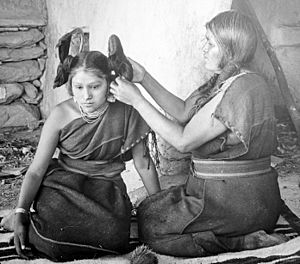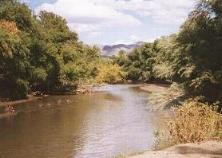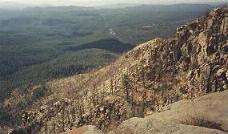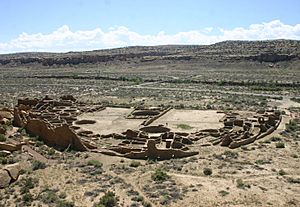Oasisamerica facts for kids
Oasisamerica is a name used by some experts to describe a large cultural area in what is now the southwestern part of North America. This area stretches from modern-day Utah down to southern Chihuahua in Mexico. It goes from the coast of the Gulf of California all the way to the Río Bravo (Rio Grande) river valley. The name "Oasisamerica" comes from its location between Mesoamerica (a region with advanced cultures) and Aridoamerica (a region mostly home to nomadic groups). American experts often call this area the Greater Southwest.
Unlike their neighbors in Aridoamerica who moved around a lot, the people of Oasisamerica mainly lived in farming societies.
Contents
Groups of People in Oasisamerica
- Ak Chin, Arizona
- Southern Athabaskan
- Chiricahua Apache, New Mexico and Oklahoma
- Jicarilla Apache, New Mexico
- Lipan Apache, Texas
- Mescalero Apache, New Mexico
- Navajo (Navaho, Diné), Arizona and New Mexico
- San Carlos Apache, Arizona
- Tonto Apache, Arizona
- Western Apache (Coyotero Apache), Arizona
- White Mountain Apache, Arizona
- Aranama (Hanáma, Hanáme, Chaimamé, Chariname, Xaraname, Taraname)
- Coahuiltecan, Texas, northern Mexico
- Cocopa, Arizona, northern Mexico
- Comecrudo Texas, northern Mexico
- Cotoname (Carrizo de Camargo)
- Halchidhoma, Arizona and California
- Hualapai, Arizona
- Havasupai, Arizona
- Hohokam, formerly Arizona
- Karankawa, Texas
- Kavelchadhom
- La Junta, Texas, Chihuahua
- Mamulique, Texas, northern Mexico
- Manso, Texas, Chihuahua
- Maricopa, Arizona
- Mojave, Arizona, California, and Nevada
- Pima, Arizona
- Pima Bajo
- Pueblo peoples, Arizona, New Mexico, Western Texas
- Ancestral Pueblo, formerly Arizona, Colorado, New Mexico, Utah
- Hopi-Tewa (Arizona Tewa, Hano), Arizona, joined the Hopi during the Pueblo Revolt
- Hopi, Arizona
- Keres people, New Mexico
- Acoma Pueblo, New Mexico
- Cochiti Pueblo, New Mexico
- Kewa Pueblo (formerly Santo Domingo Pueblo), New Mexico
- Laguna Pueblo, New Mexico
- San Felipe Pueblo, New Mexico
- Santa Ana Pueblo, New Mexico
- Zia Pueblo, New Mexico
- Tewa people, New Mexico
- Nambé Pueblo, New Mexico
- Ohkay Owingeh (formerly San Juan Pueblo), New Mexico
- Pojoaque Pueblo, New Mexico
- San Ildefonso Pueblo, New Mexico
- Tesuque Pueblo, New Mexico
- Santa Clara Pueblo, New Mexico
- Tiwa people, New Mexico
- Isleta Pueblo, New Mexico
- Picuris Pueblo, New Mexico
- Sandia Pueblo, New Mexico
- Taos Pueblo, New Mexico
- Ysleta del Sur Pueblo (Tigua Pueblo), Texas
- Piro Pueblo, New Mexico
- Towa people
- Jemez Pueblo (Walatowa), New Mexico
- Pecos (Ciquique) Pueblo, New Mexico
- Zuni people (Ashiwi), New Mexico
- Quechan (Yuma), Arizona and California
- Quems
- Solano, Coahuila, Texas
- Tamique
- Toboso
- Tohono O'odham, Arizona and Mexico
- Qahatika, Arizona
- Tompiro
- Ubate
- Walapai, Arizona
- Yaqui (Yoreme), Arizona, Sonora
- Yavapai, Arizona
- Tolkapaya (Western Yavapai), Arizona
- Yavapé (Northwestern Yavapai), Arizona
- Kwevkapaya (Southeastern Yavapai), Arizona
- Wipukpa (Northeastern Yavapai), Arizona
Affiliated and related groups
- Genízaros, originating from the Great Plains, recognized as an indigenous group in the US state of New Mexico
- Hispanos, most have mestizo ancestry, particularly in New Mexico
- Californios, California (The Californias)
- Hispanos of New Mexico (Santa Fe de Nuevo México)
- Tejanos, Texas (Coahuila y Tejas)
Geography of Oasisamerica
The name "Oasisamerica" combines "oasis" and "America." It describes a wild land with the Rocky Mountains and the Sierra Madre Occidental. To the east and west of these huge mountains are the dry plains of the Sonora, Chihuahua, and Arizona Deserts.
At its largest, Oasisamerica included parts of the Mexican states of Chihuahua, Sonora, and Baja California. It also covered parts of the U.S. states of Arizona, Utah, New Mexico, Colorado, Nevada, and California.
Even though it was mostly dry, Oasisamerica had several important rivers. These included the Yaqui, Rio Grande, Colorado, Conchos, and Gila Rivers. These rivers, and some ancient lakes, helped people develop farming. The climate was also milder than in eastern Aridoamerica, which helped farming grow.
How Oasisamerican Cultures Developed
Early Cultural Growth
The story of Oasisamerica's cultures began about 2000 years after Mesoamerica and Aridoamerica became separate cultural areas. Some groups in Aridoamerica started farming a little, along with hunting and gathering. These groups eventually became more focused on farming, leading to the rise of Oasisamerica.
Evidence from Bat Cave in Arizona shows that farming started there around 3500 BC. Since the oldest corn found in Mesoamerica dates back to 5000 BC, it seems farming ideas came from the south. It's not fully clear who brought these farming methods or how they helped the Oasisamerican cultures grow.

There are a few ideas about how Oasisamerican cultures began. One idea is that they developed on their own, thanks to a better climate. This allowed ancient desert groups to develop farming just like the Mesoamericans did.
Another idea is that nomadic groups from Mesoamerica slowly moved north over time. This would mean Oasisamericans were a branch of their southern neighbors. In this view, the cultures of Oasisamerica began with outsiders who were connected to the original people of western Mexico.
There are many signs of a strong connection between these two big cultural regions in North America. For example, the valuable turquoise stone that Mesoamericans loved came mostly from southern New Mexico and Arizona. The demand for this stone likely helped create trade routes between the two areas. Also, at Paquimé, a site linked to the Mogollon culture, experts found special buildings for Mesoamerican religious practices. They also found many macaw skeletons, showing these birds were brought all the way from the forests of southeastern Mexico.
Major Cultural Areas
The Oasisamerica region was home to several important cultural groups. These include the Ancestral Pueblo people, Hohokam, Mogollon, Pataya, and Fremont. Smaller cultures in this area include the Sinagua.
Ancestral Pueblo People

The Ancestral Pueblo culture thrived in the area now called the Four Corners. This region had many juniper forests, which the ancient people used for their needs. Other plants provided food for only half the year, failing from November to April. The Ancestral Pueblo society was one of the most complex in Oasisamerica. They are believed to be the ancestors of today's Pueblo people, including the Zuñi and Hopi. (The term "Anasazi" is also used, but it's a Navajo word meaning "enemy ancestors.")
The Ancestral Pueblo culture is the most studied ancient culture in the United States. Archaeologists have found that their culture developed over a long time, starting before the first century BC and lasting until 1540 AD. This long period includes phases like Basketmaker I, II, and III, followed by Pueblo I, II, III, and IV. In the Basketmaker II phase, the Ancestral Pueblo lived in caves and rock shelters. In the Basketmaker III phase (500–750 AD), they built the first underground villages with up to four homes in a circle.
The Pueblo period began when they started making ceramics. Their pottery often had white or red colors with black designs. During the Pueblo I phase (750–900 AD), the Ancestral Pueblo developed their first irrigation systems. Their underground homes were slowly replaced by houses made of stone. Pueblo II (900–1150 AD) is known for amazing architecture, including large buildings with many families and multiple stories. The next phase, Pueblo III (1150–1350 AD), saw the biggest growth in Ancestral Pueblo farming. They also built large communication networks that lasted until the Pueblo IV Era. In Pueblo IV (1350–1600 AD), much of their society and communication networks fell apart.

Why the Ancestral Pueblo culture declined is still a bit of a mystery. It might be linked to a long drought that hit the region from 1276 to 1299. When Europeans arrived, the Ancestral Pueblo region was home to the Pueblo Indians. These groups did not all share the same background. The Zuni had no clear relatives. The Hopi spoke an Uto-Aztecan language. The Tewas and Tiwas were Tanoanos, and the Navajo were Athabaskans.
The Pueblo Indians' religion focused on plant-like gods and the fertility of the earth. They believed that special beings called kachina came to earth from the sipapu (the center of the earth) when humans were created. Worship in Pueblo societies was led by secret groups of men who met in kivas (underground ceremonial rooms). Members of these groups claimed to represent the kachina.
Hohokam Culture

The Hohokam people lived in the desert lands of Arizona and Sonora. Their territory was bordered by two large rivers, the Salt River (Arizona) and Gila Rivers. This area is the heart of the Sonoran Desert. The hot temperatures and little rainfall made farming and living difficult. Because of this, the Hohokam built amazing irrigation systems. These included complex networks of reservoirs and canals from the Salt and Gila rivers. Some canals were several meters deep and 10 kilometers long. Thanks to these canals, the Hohokam could grow two corn crops each year.
The main Hohokam settlements were Snaketown, Casa Grande, Red Mountain, and Pueblo de los Muertos. All of these are in modern-day Arizona. The Hohokam lived in small villages with a few hundred people. Their homes were similar to the Ancestral Pueblo's Basketmaker III phase: partly underground but with large rooms. The Hohokam also made unique items. These included conch shell necklaces (brought from the coasts of California and Sonora) etched with acids. They also made axes, trowels, and other stone tools.
Archaeologists disagree about where the Hohokam culture came from. Some believe it developed on its own, pointing to Snaketown, which started in the fourth century BC. Others think the culture came from people migrating from Mesoamerica. They note that Hohokam pottery appeared around 300 BC (when Snaketown was founded). Before this, there was no sign of pottery developing in the region. Also, other technologies like the canals and practices like cremation seem to have come from western Mesoamerica.
The Hohokam culture's development is split into four periods: Pioneer (300 BC – 550 AD), Colonial (550–900 AD), Sedentary (900–1100 AD), and Classical (1100–1450 AD). The Pioneer period began with the building of the canals. In the Colonial period, connections with Mesoamerica grew stronger. This is shown by copper bells, pyrite mirrors, and ball courts found there. These trade goods and connections suggest that by the Colonial period, the Hohokam were organized into chiefdoms (groups led by chiefs). Relations with Mesoamerica lessened in the next period. The Hohokam then started building multi-story buildings like Casa Grande.
By the time Europeans arrived in the Arizona and Sonora Deserts (which they called Pimería Alta), the Hohokam cities were already empty. This was likely due to health problems and environmental issues that affected their society. The Tohono O'odham people now live in this region and speak an Uto-Aztecan language. This group had an economy based on gathering plants and some farming on mountain slopes. They were semi-nomadic, meaning they moved around, probably to find enough food in the mountain foothills where they lived.
Mogollon Culture

The Mogollon was a cultural area that stretched from the Sierra Madre Occidental mountains northward into Arizona and New Mexico in the southwestern United States. Some experts see two main cultural traditions here: the Mogollon itself and the Paquime culture that came from it. Either way, the people in this area adapted well to a landscape of pine forests, steep mountains, and ravines.
Unlike their Hohokam and Ancestral Pueblo neighbors to the north, the Mogollons usually buried their dead. Their graves often contained ceramic art and valuable stones. Because these burial sites were so rich, they were often robbed by people looking to sell the items on the black market.
Perhaps the most impressive Mogollon pottery came from the Mimbres River valley in New Mexico. Pottery making in this area was best between the eighth and twelfth centuries. It featured white pieces decorated with detailed pictures of daily life. This was very unusual in a region where most pottery had geometric patterns.
Unlike the Hohokam and Ancestral Pueblo, there isn't one widely accepted timeline for the Mogollon culture. Experts Alfredo López Austin and Leonardo López Luján used a timeline by Paul Martin. He divided Mogollon history into two main periods: the "Early" period (500 BC to 1000 AD) and the "Late" period (eleventh to sixteenth century).
The first period saw slow cultural development. Changes in technology happened very gradually, and social structures stayed almost the same for 1500 years. During the Early period, the Mogollons lived in rocky shelters. They used these to protect themselves from raiding hunter neighbors. Like the Ancestral Pueblo, the Mogollon also lived in partly underground homes, often with a kiva (a special ceremonial room).
In the eleventh century, the Mogollon population grew much faster. It's likely that during this time, the area benefited from trade with Mesoamerica. This trade helped farming grow and led to a more organized society with different social classes. It's also possible that Ancestral Pueblo influence increased then, as the Mogollon began building stone structures, just like their northern neighbors.
The Mogollon culture reached its peak in the fourteenth and fifteenth centuries. During this time, the main cultural centers grew in population, size, and power. Paquime, in Chihuahua, was probably the largest. It controlled a mountainous region with many archaeological sites called casas alcantilado. These were outposts built in hard-to-reach caves on the eastern slopes of the Sierra Madre. Paquime traded with the heart of Mesoamerica, providing valuable minerals like turquoise and cinnabar. It also controlled trade of products from the coasts of the Gulf of California, especially Nassarius conch shells. Paquime was heavily influenced by Mesoamerican societies. This is shown by the presence of arenas for the Mesoamerican ballgame and remains of tropical animals like the macaw.
The decline of the main Mogollon centers began in the thirteenth century, even before Paquime reached its peak. By the fifteenth century, much of the region was abandoned. The people of the Mimbres River moved and eventually settled in present-day Coahuila. It is thought that the Taracahitas (including the Yaquis, Mayos, Opatas, and Tarahumaras) who now live in northeastern Mexico are descendants of the Mogollones.
Fremont Culture
The Fremont area covered a large part of modern-day Utah. It was located north of the Ancestral Pueblo cultural area. Its cultural development as part of Oasisamerica happened between the fifth and fourteenth centuries. Experts believe the Fremont culture came from the Ancestral Pueblo culture. They think Fremont communities moved north, bringing Ancestral Pueblo customs, social organization, and technology with them. This idea helps explain why pottery similar to that found in Mesa Verde is also found in Utah.
Another idea suggests that the Fremont culture might have come from buffalo-hunting groups, possibly of Athabaskan origin. Over time, these groups might have adopted the culture of their southern neighbors. In both theories, the Fremont culture developed less complexly than other Oasisamerica regions because its climate was more suitable for farming.
The Fremont culture began to decline in the second half of the 10th century and was gone by the 14th century. When the Spanish arrived, the region was occupied by the Shoshones, an Uto-Aztecan group.
Pataya Culture
The Pataya area is in the western part of Oasisamerica. It includes parts of modern-day California and Arizona in the U.S., and Baja California and Sonora in Mexico. The Patayans were a smaller culture. Their cultural development was likely influenced by their Hohokam neighbors to the east. From them, they might have learned the Mesoamerican ballgame, cremation techniques, and how to make pottery.
The Patayan culture began to disappear in the fourteenth century. When the Spanish arrived in the region, the Colorado River Valley was only inhabited by the Yuman people who lived along the river.
Images for kids
See also
 In Spanish: Oasisamérica para niños
In Spanish: Oasisamérica para niños






